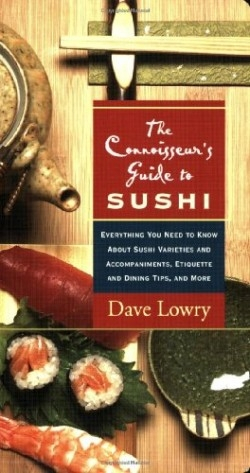The Connoisseur's Guide to Sushi
Everything You Need to Know about Sushi Varieties and Accompaniments Etiquette and Dining Tips and More
The vast majority of the hundreds of books about sushi available to readers in English seek to simplify the complexities of this cuisine. This author assumes that his readers are already fairly knowledgeable and are regulars at their local sushi-ya, or sushi restaurant. Rather than a guide for “dummies,” Lowry hopes to provide “a field guide for making your way through the world of sushi and establishing yourself as a sushi snob … as a sushi tsujin or, in the more colloquial, a sushi tsu, a ‘sushi connoisseur.’”
The book is divided into three sections. An opening overview covers the basics such as history and the various styles of sushi, including several ways of serving that diners are unlikely to find outside Japan (but a sushi tsu needs to know about them just in case). The closing section details “the practice” of sushi and covers condiments, serving dishes, and even the significance of traditional furnishings and decorations that one is likely to find at a sushi-ya.
The majority of the book, however, is an alphabetical exploration of tane, or toppings. It is with a thorough knowledge of tane that a sushi tsu makes his or her reputation. There are thirteen pages devoted to tuna (the apogee of sushi), going into detail on the various species, differences in the cuts, and other esoteric topics.
What separates a sushi tsu from a sushi “dummy” is more than a willingness to branch out beyond the California roll. It is a comprehensive awareness of the cuisine. “The sushi tsu orders hirame [flounder] only during the colder months of the year—never after February—when it has the least amount of fat,” Lowry informs the reader. A sushi tsu can also demonstrate her knowledge and gain the respect of the itamae (sushi chef) by requesting items not on the menu, such as kano-miso (crab guts)—the less frequently these items are available in the U.S. the better, of course.
Given Lowry’s goal of producing sushi snobs, his book could easily have become so pretentious as to be unreadable by anyone except, well, to be honest, snobs. But the author maintains a sense of humor throughout that thankfully cuts the pretense: “Anago [conger eel] grow to be about three feet long, and slimier than a South Side Chicago ward boss.” Another fish is described as being “about the length of a Taco Bell Burrito Supreme.”
A restaurant critic for St. Louis Magazine and a martial arts expert who has studied in Japan, Lowry has written several books about his lifelong exploration of those arts. With The Connoisseur’s Guide to Sushi, he has written an invaluable guide to a cuisine that is deeply ritualistic, very subtle, and highly demanding of those who would know it well.
Reviewed by
Erik Bledsoe
Disclosure: This article is not an endorsement, but a review. The publisher of this book provided free copies of the book to have their book reviewed by a professional reviewer. No fee was paid by the publisher for this review. Foreword Reviews only recommends books that we love. Foreword Magazine, Inc. is disclosing this in accordance with the Federal Trade Commission’s 16 CFR, Part 255.

